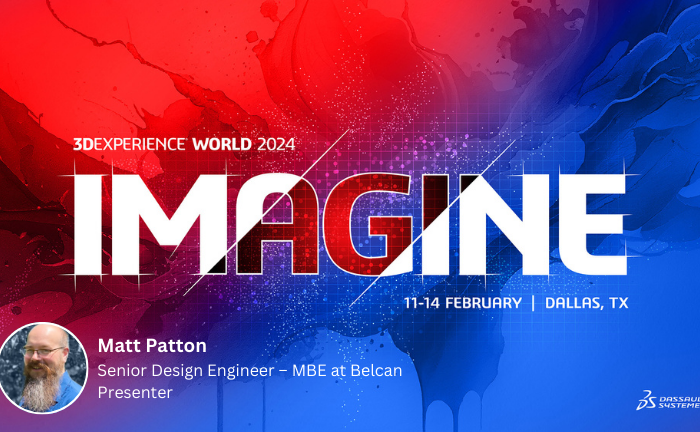Over the last few years, the term “digital transformation” has been on the radar of many professionals, entrepreneurs, and business leaders—but what this buzzy term means varies widely by industry. Regardless of vertical, those who have started to embrace the digital shift are doing so because they realize that there are significant advantages associated with a digitally transformed organization.
In the manufacturing world, model based enterprise (MBE), model based definition (MBD), and model based systems engineering (MBSE) are three business initiatives that provide frameworks to propel a digital transformation forward. Model based acronyms can be confusing, and it can be easy to use them interchangeably by mistake. To help clear up misconceptions, in this article we will cover what MBE, MBD, and MBSE mean, why they are relevant, and how they contribute to an overall digital transformation. Please refer to the embedded video and diagram below as you review these concepts.
What is a Model Based Enterprise (MBE)?
ASME Y14.47-2019 defines MBE as the following:
“An organization that uses model based definitions for the purpose of commission, operation, service, and decommission of a product.”
The scope of MBE is far reaching. Starting with the voice of the customer (VOC) in systems engineering and spanning through sustainment, MBE touches all domains from ideation to disposal of a product.
MBE is the umbrella term for an enterprise that uses digital methodologies as foundational elements for all product lifecycle phases. The quest to transform into an MBE is really a set of opportunities for organizations hoping to gain a competitive edge in the marketplace. The process entails breaking down silos, connecting databases, and improving accessibility and traceability throughout the organization and supply base. The cross-functional aspect of MBE drives value by streamlining processes throughout all lifecycle phases, increasing reuse intent and capability, improving communication and collaboration, etc.
Becoming an MBE means facilitating digital transformation via people, processes, and tools across an organization. That means considering how to digitalize legacy engineering processes, incorporating new tools and technology that can support digital workflows, and enabling a cultural shift with focused training and updated policies and procedures.
Why is MBE Important?
To be classified as an MBE, an organization must operate using digital methodologies throughout the enterprise, not just in one domain or one part of the product lifecycle. MBE is conceptually important precisely because of these requirements. In essence, they’re the driving force for large-scale digital transformation across the organization.
What is Model Based Definition (MBD)?
ASME Y14.47-2019 defines MBD as follows:
“An annotated model and its associated data elements that define the product in a manner that can be used effectively without a drawing graphic sheet.”
The scope of MBD typically includes product definition, manufacturing, and quality conformity.
MBD starts with streamlining the engineering product definition process to use 3D computer aided design (CAD) geometry models and associated product manufacturing information (PMI) as the design authority, rather than 2D artifacts. Transforming legacy methods into MBD helps engineers integrate automated workflows and enables machine consumption in addition to human consumption throughout all domains within the enterprise.
Why is MBD Important?
Moving towards MBD is a major step in any push for digital transformation in the manufacturing and engineering sectors. It represents the next logical step in progressing product definition, by displacing the analog 2D drawing with a rich 3D dataset.
Industry studies indicate it is possible to see a positive return on investment for MBD within engineering, but that return is highly dependent on how MBD is implemented and the specific use case. If all legacy 2D drawing approaches are simply transferred to 3D, this is unlikely to result in cost or time savings for engineers or other consumers of the data. In order to realize a return on investment within engineering, every element of the definition must be scrutinized and reimagined as part of the MBD transformation. Although there can be a return on investment within engineering, the larger share of MBD benefits are realized in consumption phases. To fully realize consumption value, organizations need to be laser-focused on creating unambiguous product definition that adheres to the latest industry standards and maximizes machine consumption and automated workflows.
Despite its “low-tech” nature, documentation with 2D drawings is a process that’s deeply embedded within the engineering community. Although facing the hundred plus years of headwind associated with 2D product definition can seem daunting, it is important for engineering teams to step up and support digital efforts. For engineering and manufacturing, MBD is that call to action.
How Does MBD Contribute to an MBE?
MBD is the “price of entry” for other digital initiatives that leverage the 3D models and datasets created in definition. Engineering must digitalize product definition to provide an authoritative digital definition source, otherwise 2D drawings will continue to sever the digital thread. Without modern tools and processes baked into an organization’s definition workflows, it will be exceedingly difficult to sustain other digital initiatives across an enterprise in the long term.
Organizations have realized that MBD is a prerequisite to MBE, which is why MBD is typically farther along in progression from a maturity standpoint compared to other digital initiatives.
What is Model Based Systems Engineering (MBSE)?
INCOSE defines MBSE as follows:
“Model-based systems engineering (MBSE) is the formalized application of modeling to support system requirements, design, analysis, verification and validation activities beginning in the conceptual design phase and continuing throughout development and later life cycle phases.”
The differences between MBSE and conventional systems engineering approaches begin in the very earliest stages of the engineering process. Systems engineers within an MBSE framework create a fully digitalized systems model which eventually gets brought into subsequent lifecycle phases. Unlike MBD, MBSE is not restricted to just CAD models, meaning it can leverage systems design models, simulation models, FEA models, etc.
Fully transitioning to MBSE entails carrying a model based approach through the entire engineering lifecycle. Most organizations are focused on MBSE as a technique to digitally capture traditionally paper-based systems requirements and fail to thread those digital requirements throughout subsequent phases.
Why is MBSE Important?
MBSE is important because it provides a basis for executing system-related lifecycle actions in a model based context. Engineers create the framework for system models, which are then passed on to model based design and product definition phases.
When implemented properly, MBSE works to modernize the entire engineering process by integrating systems knowledge – including language, tools, and methodology – into a model based ecosystem.
Additionally, MBSE can significantly reduce development time. MBSE can define and explore the design space prior to actual hardware creation, which can drastically reduce development risk and streamline communication between systems engineering, design, and product definition functions.
How Does MBSE Relate to MBD and Contribute to an MBE?
MBSE maps out how the elements of MBD will be used within the systems of interests across all domains of the enterprise.
MBSE contributes to digitalization of the overall enterprise because it facilitates creation of a digital thread connecting product requirements with customer requirements. In many cases, systems engineers will digitalize customer requirements to enable linkage and traceability to the systems model and auxiliary documents which can be accessed throughout the enterprise.
Incorporating MBD and MBSE are two foundational elements on the journey to becoming an MBE. Although pockets of digital practices are starting to be threaded together across the industry, the quest to fully realize the value opportunity of MBE continues. To get in touch with Belcan subject matter experts or to learn more about how Belcan can support your organization in your digital journey, click here.




